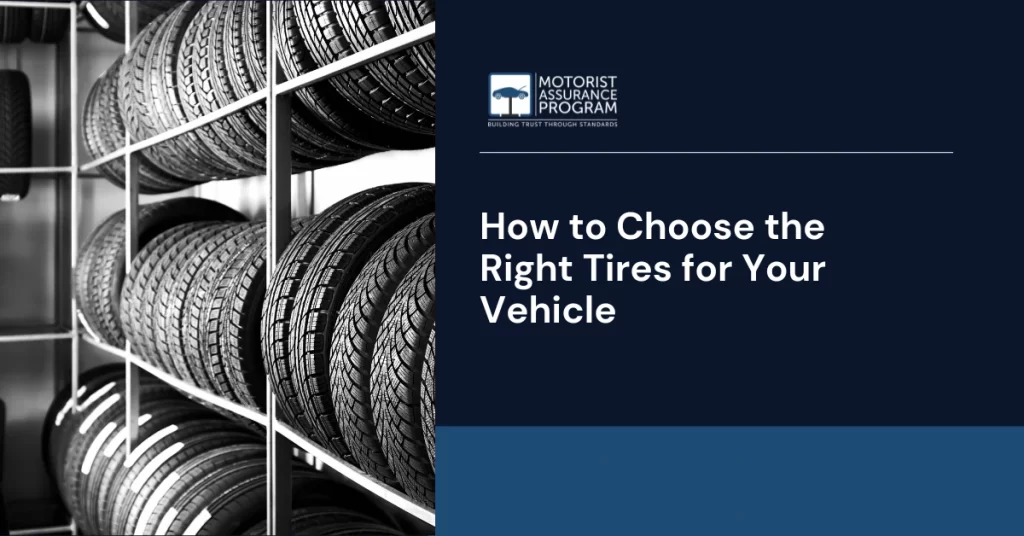Choosing the right tires for your vehicle starts with checking the tire size on the placard in your driver’s side door or fuel filler door. Consider your typical driving conditions—rainy, snowy, or mixed terrain—to select the appropriate tire type, such as all-season, winter, or performance tires. Evaluate tread patterns for longevity and grip, and regularly monitor tire wear. Ultimately, set a budget and compare brands to find a balance between quality and cost. Understanding these factors empowers you to make informed decisions that enhance your driving experience—there’s more to uncover about optimizing your tire choice.

Key Takeaways
- Check your vehicle’s tire placard for recommended tire size and specifications to ensure a proper fit.
- Assess your typical driving conditions and climate to select tires that offer the best performance for your needs.
- Choose between tire types (all-season, winter, performance) based on your local weather and driving habits for optimal traction and handling.
- Evaluate tread patterns for their suitability—symmetrical for comfort, asymmetrical for performance, and directional for wet conditions.
- Set a budget and research brands, balancing quality and price to ensure safety and reliability on the road.
Determine Your Vehicle’s Tire Size
When it comes to choosing the right tires for your vehicle, determining the correct tire size is crucial. You can start by checking the tire placard, usually found on the driver’s side door jamb or inside the fuel filler door. It provides important information about the specifications you need.
Next, you can decode the numbers and letters on your current tires. For example, a tire marked 225/65R17 indicates the width, aspect ratio, and diameter. Knowing these details helps you understand how to choose tire size that fits your vehicle’s requirements.
Additionally, consider the type of driving you do. If you frequently drive on highways or rough terrain, you might want to explore options that offer better performance.
To find the right tire size, you can also consult your vehicle’s owner’s manual or visit your local tire shop. Professionals can guide you in selecting tires that enhance safety and performance. Remember, getting the proper size not only improves handling but also optimizes fuel efficiency, ensuring a smoother ride. So, take the time to check and confidently choose the right tires for your vehicle!
Consider Your Driving Conditions and Climate
Taking into account your driving conditions and climate is essential when selecting the right tires for your vehicle. Different environments demand specific tire characteristics to guarantee safety and performance. For instance, if you frequently drive in wet or snowy conditions, you’ll want tires that provide enhanced traction and grip. On the other hand, if your area enjoys warm, dry weather, you might prioritize performance and fuel efficiency.
Here are some factors to keep in mind:
- Rainy climates: Look for tires with deep treads to channel water away and reduce hydroplaning.
- Winter conditions: Choose tires designed for cold weather, which offer specialized rubber compounds and tread patterns for better traction.
- Mixed terrain: Think about all-terrain tires if you navigate both highways and unpaved roads.
Choose Between All-Season, Winter, or Performance Tires
Choosing the right type of tire can greatly impact your vehicle’s performance and safety on the road. You need to understand the differences between all-season, winter, and performance tires to make an informed decision. All-season tires are versatile and suitable for a variety of conditions, making them an excellent choice if you live in an area with mild weather. They provide decent traction in both wet and dry conditions, but they may not perform well in extreme winter weather.
If you frequently encounter snow and ice, winter tires are the best option. These tires are specifically designed with deeper treads and softer rubber compounds that stay pliable in cold temperatures, guaranteeing better grip and control.
On the other hand, if you prioritize speed and handling, performance tires are your go-to. Ideal for sporty vehicles, these tires enhance responsiveness and cornering, but they may lack durability in harsh weather.
To learn how to choose the right tires for your car, consider your driving habits, climate, and vehicle type. By knowing how to pick the right tires, you’ll assure your safety and optimize your vehicle’s performance.
Evaluate Tread Patterns and Longevity
Understanding how tread patterns affect your tire’s performance and longevity is key to maximizing safety and efficiency on the road. The right tread pattern can enhance traction, reduce hydroplaning, and improve fuel efficiency, especially when you’re figuring out how to choose the right tires for electric cars.
Here are some factors to take into account while evaluating tread patterns:
- Symmetrical Tread: Offers a smooth, quiet ride and is suitable for all-season use.
- Asymmetrical Tread: Provides enhanced grip and cornering stability, ideal for performance tires.
- Directional Tread: Designed for peak water evacuation, it’s great for wet conditions.
When reviewing tire longevity, keep in mind the tread wear indicators and regularly check for uneven wear. This can signal alignment issues or improper inflation. Choosing the right tires isn’t just about performance; it’s also about ensuring they last. By understanding these elements, you’ll be better equipped to choose tires that meet your driving needs and keep you safe on the road. Remember, investing time in evaluating tread patterns could save you money and enhance your driving experience.
Set a Budget and Compare Brands
Setting a budget for your tire purchase is essential to ensuring you get the best value without compromising safety. Start by determining how much you can comfortably spend. Remember, tires are a significant investment that impacts your vehicle’s performance, fuel efficiency, and safety on the road.
Once you’ve set your budget, it’s time to compare brands. Research various manufacturers and their offerings within your price range. Look for reviews and ratings from other drivers to gauge performance and reliability. Remember that while premium brands might come with a higher price tag, their durability and performance can save you money in the long run.
Consider the type of driving you’ll do. If you frequently drive in harsh conditions, investing in high-quality tires could be worth it. On the other hand, if you mainly drive in mild weather, a more affordable option might suffice.
Ultimately, knowing how to choose the right tire involves balancing your budget with quality. By comparing brands and understanding what you need, you’ll be better equipped to decide what tires to buy, ensuring a safe and enjoyable driving experience.
Frequently Asked Questions
How Often Should I Rotate My Tires?
You should rotate your tires every 5,000 to 7,500 miles or as recommended by your vehicle’s manufacturer. Regular rotation helps guarantee even wear, extending tire life and maintaining peak performance for safer driving conditions.
What Is the Recommended Tire Pressure for My Vehicle?
You should check your vehicle’s owner’s manual for the recommended tire pressure. Typically, it ranges between 30 and 35 psi. Maintaining proper pressure guarantees safety, improves fuel efficiency, and extends tire life. Regularly check it!
When Should I Replace My Tires?
Replacing your tires is like changing your shoes; worn-out tires compromise safety. Check tread depth regularly, and if it’s less than 2/32 inches, or you notice cracks or bulges, it’s time for new tires.
Can I Mix Different Tire Brands on My Vehicle?
Mixing different tire brands isn’t recommended. It can lead to uneven wear and handling issues. For best performance, stick to the same brand and model on all four tires, ensuring consistency and safety on the road.
How Do I Know if My Tires Are Properly Balanced?
Did you know that unbalanced tires can reduce your fuel efficiency by up to 15%? To check if your tires are balanced, look for vibrations while driving or uneven tread wear, indicating they may need adjustment.
Conclusion
In the grand journey of driving, choosing the right tires is your first step toward safety and performance. Just as a knight wouldn’t venture into battle without armor, you shouldn’t hit the road without the right tires. By considering your vehicle’s needs, your driving habits, and the weather, you’ll be well-equipped for any adventure. So, take the plunge and invest in tires that not only fit your vehicle but also enhance your driving experience. Your safety depends on it!


